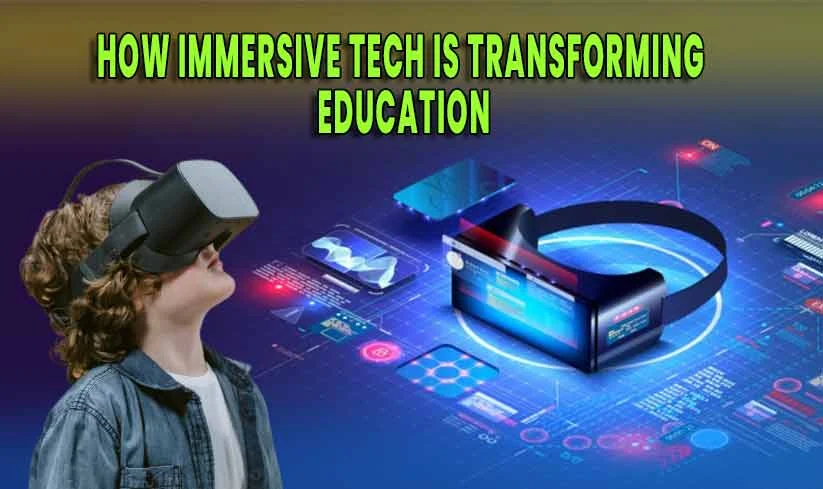How Immersive Tech Is Transforming Education
From virtual excursions to interactive simulations, immersive technology is dismantling geographical and financial obstacles, providing students with personalized and experiential learning opportunities like never before. This article examines how immersive technology is transforming education, highlighting its primary advantages, practical applications, and future potential.
1. What Is Immersive Technology in Education?
Immersive technology encompasses digital tools that generate simulated or enhanced environments, enabling users to engage with virtual or augmented components. In the educational context, these technologies include:
- Virtual Reality (VR): Completely digital environments accessed through headsets (e.g., Meta Quest, HTC Vive).
- Augmented Reality (AR): Digital enhancements superimposed on the real world (e.g., smartphone applications like Pokémon GO).
- Mixed Reality (MR): A combination of physical and virtual interactions (e.g., Microsoft HoloLens).
- Extended Reality (XR): A comprehensive term that includes VR, AR, and MR.
These tools facilitate experiential learning, allowing students to actively engage in lessons rather than merely reading or observing.
2. Key Advantages of Immersive Technology in Education
A. Improved Engagement and Information Retention
Conventional lectures often result in passive learning, which can lead to a lack of interest. Immersive technology transforms the learning experience into an interactive and enjoyable process, thereby enhancing motivation. Research indicates that learners using virtual reality retain between 75% and 90% of the information, in contrast to a mere 10% retention rate from traditional reading.
B. Practical, Experiential Learning
Students have the opportunity to develop real-world skills within a safe environment. For instance:
- - Medical students can conduct virtual surgeries.
- - Engineering students can assemble machines in a virtual setting.
- - History students can navigate ancient civilizations in a three-dimensional space.
C. Enhanced Accessibility and Inclusivity
Immersive technology eliminates both physical and financial obstacles:
- - Students in remote locations can participate in virtual labs or field trips.
- - Learners with disabilities can engage in immersive training for sign language or braille through virtual reality.
D. Customized Learning Experiences
Artificial intelligence-driven virtual and augmented reality can adjust to the unique learning pace of each student, providing tailored lessons based on individual performance.
E. Secure Learning Environments
Hazardous training scenarios, such as firefighting or chemical experiments, can be simulated without exposing students to real-world dangers.
3. Practical Uses of Immersive Technology in Education
A. Virtual Classrooms and Remote Learning
Platforms such as Engage VR and AltspaceVR enable students to join 3D virtual classrooms, interact with fellow learners, and engage in collaborative projects, effectively bridging the divide in online education.
B. Virtual Field Trips
Rather than merely reading about the Pyramids of Giza, students can explore them in virtual reality through applications like Google Expeditions. Additionally, museums, space agencies, and zoos provide virtual tours for an enriched learning experience.
C. Medical and Scientific Training
- Surgical Simulations: Platforms such as Osso VR provide surgeons with training through realistic surgical scenarios.
- Anatomy Lessons: Augmented reality applications like Complete Anatomy enable students to investigate 3D representations of the human body.
D. STEM and Engineering Education
- Virtual Reality Physics Laboratories: Students are able to perform experiments in simulated environments, exemplified by platforms like Labster.
- Augmented Reality Engineering Models: Applications such as Blippar project 3D designs onto physical objects.
E. Language Acquisition and Cultural Engagement
Applications like Mondly VR facilitate language learners in practicing dialogues with AI avatars in authentic environments, such as ordering meals in Paris.
F. Special Education and Therapeutic Support
- Autism Assistance: Virtual reality aids children with autism in honing their social skills.
- Phobia Management: Virtual reality exposure therapy supports individuals in confronting and overcoming their fears, such as acrophobia.
4. Challenges and Limitations
Despite its promising capabilities, immersive technology encounters several challenges:
A. High Expenses
The cost of VR headsets and AR devices can be prohibitive, restricting access for schools with limited funding.
B. Technical Challenges
- Effective use of these technologies necessitates robust internet connectivity and advanced hardware.
- Additionally, some educators may not have the necessary training to implement VR and AR effectively.
C. Health Issues
Extended use of virtual reality may lead to motion sickness or visual discomfort.
D. Quality of Content
Not all educational VR and AR materials are well-crafted or aligned with educational standards.
5. The Future of Immersive Education
The upcoming decade is poised to witness a greater incorporation of immersive technology within the educational landscape:
A. AI and VR for Tailored Learning Experiences
Artificial Intelligence will evaluate student performance within virtual reality environments and modify lessons instantaneously.
B. Haptic Feedback and Comprehensive Sensory Engagement
Future iterations of virtual reality may incorporate tactile sensations, olfactory experiences, and temperature variations to enhance immersion.
C. Classrooms in the Metaverse
Educational institutions may function within decentralized virtual realms, enabling students from various countries to learn collaboratively.
D. Cost-Effective and Portable Solutions
As technology becomes more affordable, augmented reality on smartphones and lightweight virtual reality devices are expected to prevail.
Conclusion
Immersive technology is transforming education by making learning more interactive, engaging, and accessible. Although challenges such as costs and the need for training persist, the advantages—improved retention, practical experience, and international collaboration—significantly outweigh the disadvantages.
As virtual reality, augmented reality, and artificial intelligence continue to advance, future classrooms will be limitless, immersive, and customized to meet the unique needs of each student. Educational institutions and policymakers must prioritize investments in these technologies to ensure equitable access and adequately prepare students for a digitally sophisticated future.
The future of education transcends traditional books and screens; it invites us to explore new realms of knowledge.







